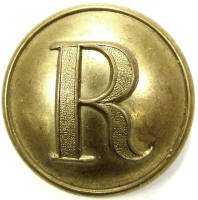
A virtual examination of artifacts of the American Civil War
 |
Ridgeway Civil War Research Center, A virtual examination of artifacts of the American Civil War |
| Civil War Artillery | |
| by Harry Ridgeway |
| Rifled artillery projectile, Sawyer design, Federal manufacture, bursting shell, lead sabot with lead sleeve and pre-cast flanges, Sawyer percussion fuze, Sawyer rifle, 6 in. Projectile was manufactured in the Federal arsenals, following the design of Addison M Sawyer. The sabot system was designed with a massive lead sabot covering the entire base and the sides , including six flanges cast into the shell, it apparently proved unsatisfactory because the excessive lead consumed would gum up the bore on the cannon , and the elasticity of the lead probably lessened the dispersion of fragments. These large caliber Sawyers were field trialed at Mobile Bay, but were judged to be unsatisfactory, the lead sabot had a tendency to partially peel off on firing causing directional instability, the soft lead would gum up and damage the bore of the guns, and the percussion fuze was ineffective in soft dirt fortifications. Shell is equipped with the Sawyer percussion fuze, Jones pg. 33. Mark on nose, "42" is probably an indication of the powder bursting charge. Bottom is marked with Sawyer patent date. Shell measures: Diameter 5.96in. from the outer lead grooves, 5.7in. from the inner lead grooves, length 11.75in. (excluding fuze), weight 38lbs. Research Center: Artillery5241-Sawyer, Ref: Bell, Heavy Ordnance, pg. 357. Details click: http://relicman.com/artillery/Artillery5241-Sawyer.html. |
| Ridgeway Civil War Research Center, A virtual examination of artifacts of the American Civil War. Artillery Research center, artillery, click: http://relicman.com/artillery/Artillery0000-Index.html. Research center, artillery, click: http://relicman.com/artillery/Artillery0000-Index.html. |
| Civil War Relicman, Harry Ridgeway, Civil War artillery, Relicman sales catalog. Click here: http://relicman.com/artillery/RelicmanSalesArtillery1.html. Artillery for sale: http://relicman.com/artillery/RelicmanSalesArtillery1.html. |